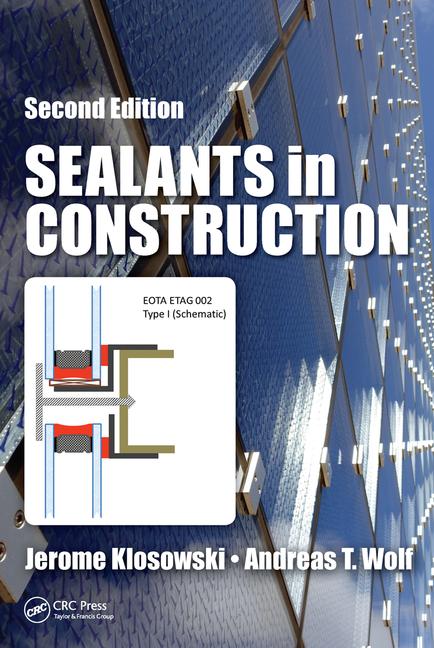A New Building Standard
More U.S. building contractors are switching to polyether-based sealants and adhesives for performance, safety, and low VOCs.

 Polyether-based sealants and adhesives, the advanced formulation polymers that have overtaken urethane and silicone products in Japan and Europe, are now becoming the new standard among U.S. architects and contractors for use throughout the entire building envelope-from foundation to roof. In the past year, the use of polyether-based sealants has nearly doubled for both new construction and repair work. The driving forces behind this increased popularity are the superior performance and environmental compliance characteristics of polyether-based sealants and adhesives, compared to many urethane- and silicone-type products.
Polyether-based sealants and adhesives, the advanced formulation polymers that have overtaken urethane and silicone products in Japan and Europe, are now becoming the new standard among U.S. architects and contractors for use throughout the entire building envelope-from foundation to roof. In the past year, the use of polyether-based sealants has nearly doubled for both new construction and repair work. The driving forces behind this increased popularity are the superior performance and environmental compliance characteristics of polyether-based sealants and adhesives, compared to many urethane- and silicone-type products.
“Polyether-based adhesives and sealants are water-cured and contain no solvents,” explains engineering consultant Richard Boone, president of Construction Support Services in Centennial, CO. “Therefore, they have no shrinkage, possess excellent adhesion properties, and are very durable yet retain excellent flexibility.”
Because these advanced sealants and adhesives contain no solvents, they produce very few volatile organic compounds (VOCs). In addition to the environmental benefit, this also makes polyether-based products compliant with increasingly stringent local and state VOC regulations. (VOCs are substances that evaporate into the atmosphere, contributing to climate change, chronic respiratory disorders and cancer. In addition, many sealants that produce VOCs are flammable, produce irritating odors and tend to degrade over time.)
“The polyether backbone, which is a long-chain hydrocarbon, is very stable,” explains Boone. “The long chain makes it inherently resistant to the effects of weather, so you don’t need to mix in a lot of other stabilizing chemicals to make it durable. The water-based cure system creates a very strong bond, so these polyether sealants and adhesives will adhere to virtually all surfaces. That property enables them to hold tight and makes them applicable to seams and joints throughout construction and repair projects.”
Once a polyether-based sealant or adhesive is applied, it reacts with moisture in the air and crosslinks to form a tough, long-lasting, flexible chain. It cures rapidly, adheres to a wide range of materials, meets the toughest standards for joint movement, won’t shrink and won’t suntan.
Boone cites the work of Chem Link Advanced Architectural Products (Schoolcraft, MI) in developing and popularizing the use of polyether compounds throughout the U.S. Chem Link has developed of a variety of products that address assorted adhesive and sealant requirements throughout the building envelope.
“Chem Link has taken a polymer that is known for having an excellent basis for adhesives and sealants and then created formulas that allow you to do an enormous amount of different tasks very well,” Boone explains. “By careful compounding and blending of different ingredients, the company has virtually rewritten the book, developing a range of products that offer distinct advantages for applications involving seams throughout the building structure.”

Polyether-based adhesives and sealants are cured by water they draw from the air, so there are no solvents to evaporate and cause shrinkage. Because these products cure from the top down and the bottom up, they are watertight and fairly durable within 10-20 minutes, though they typically take two to three weeks to completely cure. At this point, as Graham notes, they become hard as a hockey puck but remain “remarkably” flexible.
“The material is also easy to work with, seals better, and lasts longer. We have not had a single callback, which is notable in our industry,” he says.
“The green aspect of the polyether-based, one-part product wasn’t so important in the past, but it is important now,” confirms Boone. “In the case of the Chem Link products, you’re using material that is 100% solid. You are dealing with no solvent release, almost no VOCs and no objectionable odors. You can safely work with these materials inside the building as well as outside.”
Boone adds that in using these products, contractors don’t have to worry about confined spaces, flammability or whether they will contaminate some other material. “These polyether-based materials are very safe for the person in the work environment, and they are ultimately safe for the building occupants both during and after construction,” he says.
For more information, contact Chem Link at 353 E. Lyons St., Schoolcraft, MI 49087; phone (269) 679-4440; fax (269) 679-4448; e-mail gnelson@chemlinkinc.com; or visit www.chemlink.com.

Polyether-based sealants and adhesives are safer to use and better for the environment.

Once a polyehter-based sealant or adhesive is applied, it reacts with moisture in the air and crosslinks to form a tough, long-lasting, flexible chain.
“Polyether-based adhesives and sealants are water-cured and contain no solvents,” explains engineering consultant Richard Boone, president of Construction Support Services in Centennial, CO. “Therefore, they have no shrinkage, possess excellent adhesion properties, and are very durable yet retain excellent flexibility.”
Because these advanced sealants and adhesives contain no solvents, they produce very few volatile organic compounds (VOCs). In addition to the environmental benefit, this also makes polyether-based products compliant with increasingly stringent local and state VOC regulations. (VOCs are substances that evaporate into the atmosphere, contributing to climate change, chronic respiratory disorders and cancer. In addition, many sealants that produce VOCs are flammable, produce irritating odors and tend to degrade over time.)
Rewriting the Book
Boone, a longtime engineer, specifier and compounder, chairs the committee that was chartered to develop an ASTM International standard for polyether-based sealing materials. He says that, although the initial acceptance of polyether-based adhesives and sealants was based on roof work, these products are now increasingly popular for joints, seams or laminations (including wall panels, windows, doors, pavements and countertops).“The polyether backbone, which is a long-chain hydrocarbon, is very stable,” explains Boone. “The long chain makes it inherently resistant to the effects of weather, so you don’t need to mix in a lot of other stabilizing chemicals to make it durable. The water-based cure system creates a very strong bond, so these polyether sealants and adhesives will adhere to virtually all surfaces. That property enables them to hold tight and makes them applicable to seams and joints throughout construction and repair projects.”
Once a polyether-based sealant or adhesive is applied, it reacts with moisture in the air and crosslinks to form a tough, long-lasting, flexible chain. It cures rapidly, adheres to a wide range of materials, meets the toughest standards for joint movement, won’t shrink and won’t suntan.
Boone cites the work of Chem Link Advanced Architectural Products (Schoolcraft, MI) in developing and popularizing the use of polyether compounds throughout the U.S. Chem Link has developed of a variety of products that address assorted adhesive and sealant requirements throughout the building envelope.
“Chem Link has taken a polymer that is known for having an excellent basis for adhesives and sealants and then created formulas that allow you to do an enormous amount of different tasks very well,” Boone explains. “By careful compounding and blending of different ingredients, the company has virtually rewritten the book, developing a range of products that offer distinct advantages for applications involving seams throughout the building structure.”

Polyether-based adhesives and sealants include no solvents to evaporate and cause shrinkage.
No More Shrinkage
“Our initial interest in polyether-based adhesives and sealants was the fact that they don’t shrink, as many solvent-based urethane and silicone products do,” says Paul Graham of manufacturers’ rep firm Moore Graham Sales, Inc. in Granbury, TX. “If they shrink, they leak, because water simply runs behind the material. Of course, that causes major damage and other problems.”Polyether-based adhesives and sealants are cured by water they draw from the air, so there are no solvents to evaporate and cause shrinkage. Because these products cure from the top down and the bottom up, they are watertight and fairly durable within 10-20 minutes, though they typically take two to three weeks to completely cure. At this point, as Graham notes, they become hard as a hockey puck but remain “remarkably” flexible.
“The material is also easy to work with, seals better, and lasts longer. We have not had a single callback, which is notable in our industry,” he says.
The Power of Green
Graham adds that, although the polyether adhesives and sealants were initially popular because of their superior performance properties, the no-solvent chemistry has more recently added to sales.“The green aspect of the polyether-based, one-part product wasn’t so important in the past, but it is important now,” confirms Boone. “In the case of the Chem Link products, you’re using material that is 100% solid. You are dealing with no solvent release, almost no VOCs and no objectionable odors. You can safely work with these materials inside the building as well as outside.”
Boone adds that in using these products, contractors don’t have to worry about confined spaces, flammability or whether they will contaminate some other material. “These polyether-based materials are very safe for the person in the work environment, and they are ultimately safe for the building occupants both during and after construction,” he says.
For more information, contact Chem Link at 353 E. Lyons St., Schoolcraft, MI 49087; phone (269) 679-4440; fax (269) 679-4448; e-mail gnelson@chemlinkinc.com; or visit www.chemlink.com.
Links
Looking for a reprint of this article?
From high-res PDFs to custom plaques, order your copy today!






